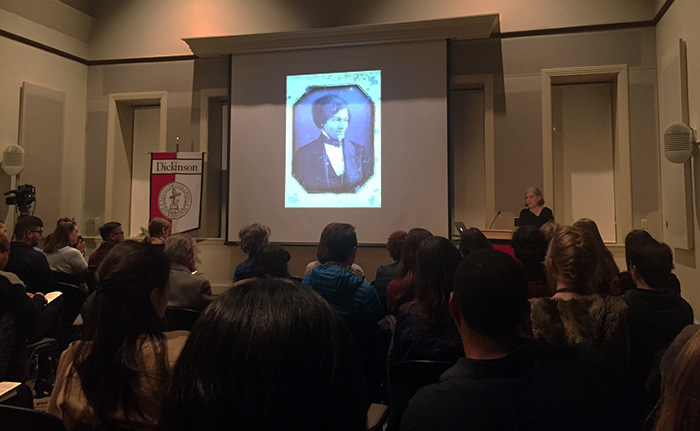Picturing Humanity

Photo courtesy of Tara Fischer.
Prestigious residency explores photography as a tool for social change
by MaryAlice Bitts-Jackson
If you’ve studied the Abolitionist movement, you’ve seen at least one portrait of Frederick Douglass, the most-photographed man of his time. Taken when photography was new, these photos symbolize Douglass’ profound contributions. They also are relics of a forward-looking campaign to use visual culture and technology to help build a more just society after the American Civil War.
Several centuries later, Dickinson hosted a residency focusing on Douglass’ early adoption of photography to advance African American rights, and the reverberations of that campaign today. Presented by a campus organization that was recently lauded for its interdisciplinary programming, the residency included a public lecture on visual culture, a tour of Dickinson’s art studios and a trip to a historic institution that used photography to very different ends.
Same tool, different aims
The resident was Laura Wexler, co-director of the Public Humanities Program and founder and director of the Photographic Memory Workshop at Yale University, whose cross-disciplinary research focuses on photography and visual culture. During her November visit, she presented a public address on Douglass’ work to spotlight the humanity and dignity of African Americans through photographic portraiture. She also attended a formal reception and shared meals, on and off campus, with students and American-studies faculty, and took a private tour of Goodyear Studios and The Trout Gallery with Willa Hut ’17 (art & art-history) major.
And on Friday afternoon, she traced connections between her own work and research surrounding the nearby Carlisle Indian School.
Wexler’s interest in the school stemmed from the important role that photography played in its history. The Carlisle Indian School’s founder, Richard Pratt, took two photographs of each of his students: the first, just after their arrival, after a long and dusty journey by train; the second, after they’d been bathed, groomed and dressed in Western garb. The before-and-after photos were meant to publicize his school, which sought to “civilize” Native American youth by assimilating them into Western culture. So while Douglass used photographs as a public-relations tool to show the dignity and worth of African Americans, Pratt used them juxtapose the “savagery” of another oppressed culture with his own.
The professor explored these parallels during an hourlong private tour of the Indian School, courtesy of Frank Vitale ’16, who had worked with the Carlisle Indian School Digital Resource Center as a history major, and is serving a yearlong internship in Dickinson's Archives & Special Collections through the Friends of the Library program.
High honors
Wexler had come to Dickinson through Phi Beta Kappa (PBK), a prestigious honor society that has promoted excellence, freedom of thought and expression and liberal arts and sciences since its founding in 1776. There are 286 PBK chapters at colleges and universities across the U.S.; those who host PBK residencies must compete for the honor.
According to Tara Vasold Fischer ’02, associate dean of academic advising & college dean and president of PBK 's Alpha of Pennsylvania, this year marks the second time in the college’s history that Dickinson has applied for and has been granted a PBK residency. It’s high praise for the chapter and the college, and it arrives on the heels of another national honor society accolade, as Dickinson received the Alpha Lambda Delta Maintaining the Flame Award, recognizing excellence in programming, last year (Jillian Paffenbarger '18 and Norma Jean Park '18 received prestigious ALD scholarships as well).
The societies, and the programming and residencies they offer, give the Dickinson and greater Carlisle community “fantastic opportunities to engage with leading scholars from across the United States,” notes Vitale, a PBK member. “They are a perfect complement to Dickinson’s liberal-arts curriculum,” he adds, “and I am especially glad that my organization is helping to support these intellectual opportunities for Dickinson and Central Pennsylvania.”
Learn more
- “A More Perfect Likeness”
- Phi Beta Kappa
- “Histories, Memories and Reclamations”
- The Liberal Arts at Dickinson
- Latest News
Published December 13, 2016